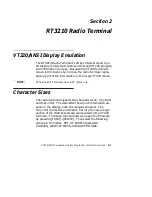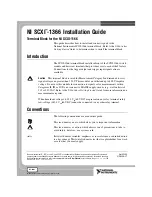
SECTION 2
"
RT3210 Radio Terminal
2-2
VT220/ANSI Terminal Emulation Programmer’s Reference Guide
When the radio terminal powers up, it defaults to a 7-by-9
dot character size. This size is the larger of the two charac-
ter sets, and yields a screen size of 16 columns by 9 lines of
display information (the bottom line is reserved for annun-
ciators and system messages). The total number of charac-
ters this size can display is 144.
The 5-by-7 dot character size yields a screen size of 21 col-
umns by 15 lines (the bottom line is reserved for annuncia-
tors and system messages). The total number of characters
this size can display is 315.
Screen Modes
The radio terminal has these screen modes: center cursor,
corner, page, lazy, screen lock, and locked. The modes pres-
ent a window onto a standard VT220 display buffer. You
can set the type of screen mode through the radio terminal’s
firmware menus.
You can move the cursor by using the four direction arrows
on the radio terminal’s diamond-shaped keypad. When you
try to move the cursor onto one of the boundaries, an error
tone sounds and the display retains its last position.
The screen modes govern which portion of the larger VT220
terminal’s screen the radio terminal first presents and how
the window moves as the cursor moves.
Center Cursor Mode
Center cursor mode works best for applications that use the
entire VT220 data stream’s 80-character by 24-line logical
display. In this mode, the cursor remains in the center of
the radio terminal’s window.
Summary of Contents for VT220/ANSI
Page 4: ......
Page 18: ...CONTENTS xiv VT220 ANSI Terminal Emulation Programmer s Reference Guide...
Page 26: ...SECTION 1 Introduction 1 8 VT220 ANSI Terminal Emulation Programmer s Reference Guide...
Page 264: ...APPENDIX A Bar Code Scanning A 4 VT220 ANSI Terminal Emulation Programmer s Reference Guide...
Page 276: ...INDEX Index 12 VT220 ANSI Terminal Emulation Programmer s Reference Guide...
















































